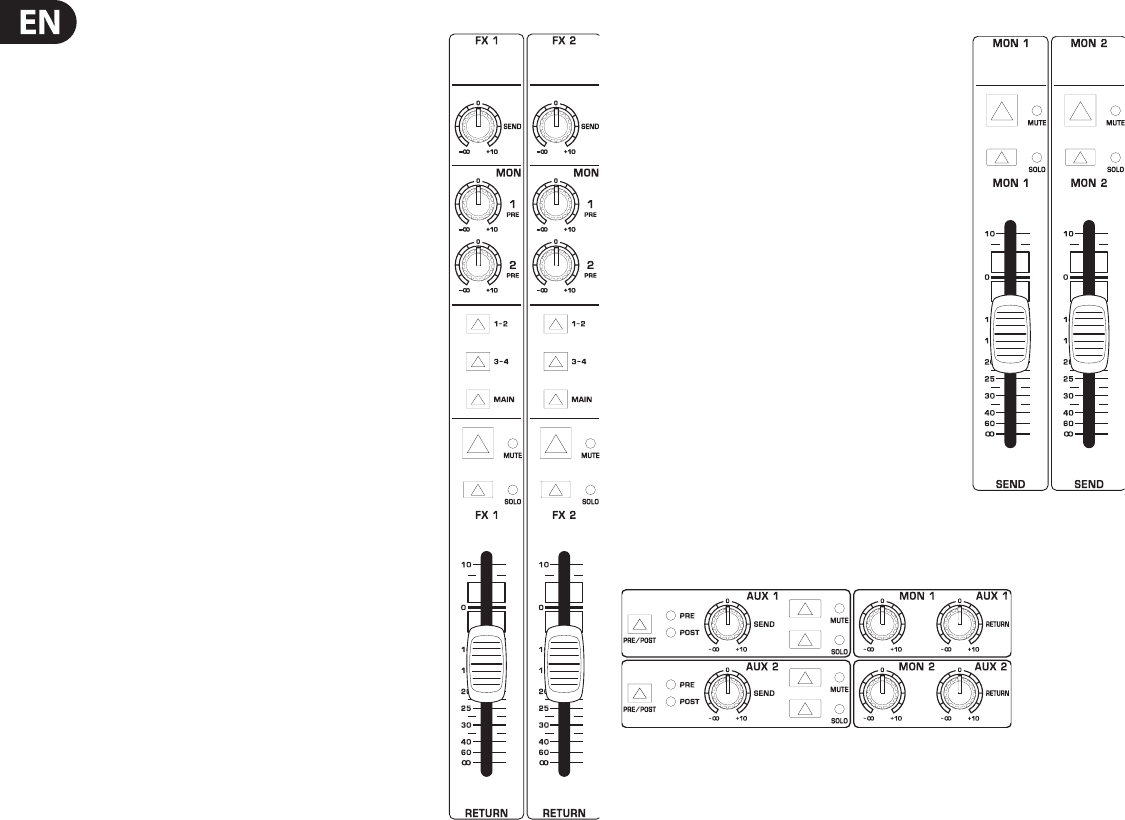
behringer.com
16 XENYX XL1600/XL2400/XL3200 User Manual
FX master section5.7
This section has additional inputs for signals which do
not require further signal processing. Ideally, use them
for signals returning from external eects units. This
is why these inputs are referred to as FX returns. It is
possible to route the eect signals to the monitors
and subgroups. This way the stereo channels can be
used for additional stereo signals, such as keyboards,
etc., and not for eects units' signals which require
functions like fader, routing, solo and mute.
FX SEND
This is the master FX SEND control for adjusting the
volume of all FX send signals at the corresponding
FX send jacks and at the inputs of the built-in
eects processor. Use it to control the master signal
of all FX 1/FX 2 signals from the input channels.
When neither of the FX SEND controls is turned up,
the eects processor will not receive a signal.
MON
Use the MON controls to add an eect signal to the
monitor buses 1 and 2. For this application, the eects
unit needs a signal: turn up the respective master
FX SEND control and the FX send controls on the
channel strips (34) and pull up the channel faders.
1-2, 3-4
These selector switches route the eect signal to the
main mix or to the subgroups 1-2 or 3-4. For example,
if you create a subgroup for a choir, you need to feed
the eect, which processes the vocal signal, to the
same subgroup so that all signals can be adjusted
equally. In this case it doesn't matter that the FX
sends are routed post-fader as long as the choir's
volume level is adjusted with the subgroup fader. Otherwise, the eect signal is
perceived as unaected in the main mix.
MUTE
The MUTE switch mutes the eect return path. Use this function to deactivate
the reverb eect of a vocalist who makes announcements between songs.
The corresponding MUTE LED indicates that the channel is muted.
SOLO
Press the SOLO switch to listen in on the eect signal on the headphones/
speakers as well as see it on the monitor meter 1/2. The corresponding LED lights
up when the solo function is activated.
FX RETURN
The FX return fader adjusts the volume level of the returned eect signal in the
main mix and subgroups (this depends on the routing switch you have pressed).
Monitor send section5.8
The monitor send section merges the monitor
signals of all channels. Then the mix is sent to the
monitor outputs. The monitor fader provides precise
adjustment and optical control of the monitor
output signals.
SEND
The SEND faders control the output level of the
monitor buses. Each fader is 60 mm long and features
10 dB headroom.
MUTE
Each monitor send has a MUTE switch and MUTE LED.
SOLO
For acoustic control of the stage sound, use the SOLO
switch to feed the monitor signal to the headphone
and speaker output. If you connect the speaker
output to a monitor that is identical with the monitor
speakers on stage, you can tell how the stage sound is perceived.
AUX master section5.9
This section is split up in an aux send section (left side) and an aux return
section (right side). The aux send paths 1 and 2 can individually be switched from
pre-fader to post-fader depending on whether you want to use them as monitor
or eect signal paths. As with all outputs, both aux master outputs feature 10 dB
headroom as well as a MUTE and SOLO switch.
In the aux return section, you can adjust the signals of the devices (CD player,
eects unit, submixer, etc.) connected to the aux inputs which are then routed to
the monitor buses and the main mix.
PRE/POST
This is the global PRE/POST switch for the aux buses. For utmost exibility,
each AUX bus can individually be switched from pre-fader to post-fader.
AUX SEND
The Master AUX SEND controls 1 and 2 adjust the signals' volume level of the
respective aux send connector. This way you adjust the sum of the AUX 1 and
AUX 2 signals on the input channels.
MUTE
The MUTE switch mutes the aux outputs.
SOLO
The aux send signals can individually be listened to using the SOLO function.


















